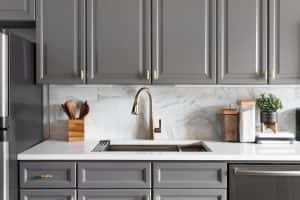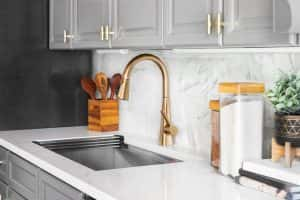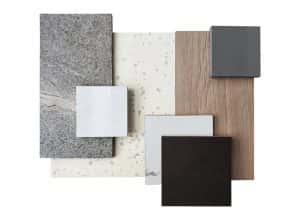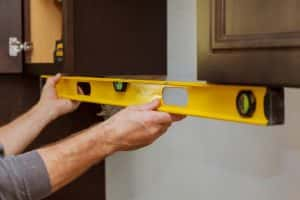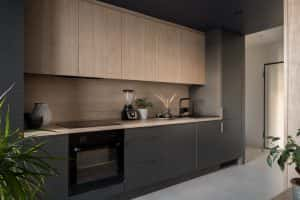
You’ve bought a brand-new home, and are trying to decide between a modular kitchen and a carpenter-made one. Which is the better option, and why? We break down the features of each and tell you what are the pros and cons, so that you can make an informed decision!
Let’s find out which is the option that wins, in the modular kitchen vs normal kitchen debate!
Importance of Kitchen Design in Homes
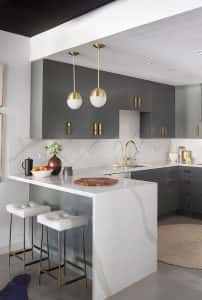 Your kitchen is the heart of your home, and its importance cannot be emphasised enough. A well-designed kitchen is one that’s easy to use, where everything is in its place and easy to access when you need it; yet tucked away out of sight when you don’t! It has clear working zones, an ergonomic and space-efficient layout, and is functional and practical. Above all, it matches your personality and reflects your taste.
Your kitchen is the heart of your home, and its importance cannot be emphasised enough. A well-designed kitchen is one that’s easy to use, where everything is in its place and easy to access when you need it; yet tucked away out of sight when you don’t! It has clear working zones, an ergonomic and space-efficient layout, and is functional and practical. Above all, it matches your personality and reflects your taste.
We tend to spend more time in the kitchen than in any other space in our homes, and by paying attention to the design of your kitchen you can create a space that works well— and, above all, keeps you happy!
Overview of Modular Kitchens and Traditional Kitchens
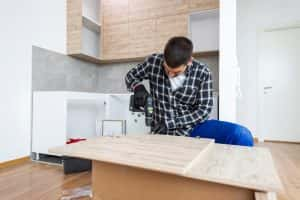 Deciding between a modular kitchen and a traditional one isn’t always easy. On the one hand, you might have fallen in love with the glossy, sleek designs that you’ve seen in a modular kitchen catalogue. But then you have a dozen relatives telling you that unless you go down the ‘normal’ route, which is opting for a carpenter-made kitchen, you will not get the customisation you want, and you’ll end up paying a lot more. This is confusing, indeed!
Deciding between a modular kitchen and a traditional one isn’t always easy. On the one hand, you might have fallen in love with the glossy, sleek designs that you’ve seen in a modular kitchen catalogue. But then you have a dozen relatives telling you that unless you go down the ‘normal’ route, which is opting for a carpenter-made kitchen, you will not get the customisation you want, and you’ll end up paying a lot more. This is confusing, indeed!
Let’s take a closer look at each type of kitchen before you make this all-important decision.
Characteristics of a Modular Kitchen
What, then, are the characteristics of a modular kitchen?
Definition and Features
As the name implies, a modular kitchen is one that can be easily broken down into its component parts or modules. These kitchens come in predetermined sizes and finishes. Modular kitchens are manufactured and finished in the factory, and are only assembled at site, making the installation very quick and efficient. They are characterised by their ergonomic use of space, contemporary designs and versatility.
1. Built-in Modules and Cabinets
Built-in modules and cabinets are the integral building blocks of modular kitchens. They play a crucial role in enhancing functionality, optimising space, and contributing to the overall look and feel of your kitchen. These can be categorised into three types: base cabinets, wall cabinets, and tall units.
Each of the cabinets can be fitted with storage accessories to streamline organisation and facilitate ease of use. Some examples of these accessories are specialised drawer systems, such as cutlery trays and pot-and-pan organisers. Pull-out shelves and trays offer space to store groceries, utensils and other kitchen essentials.
2. Customisation and Flexibility
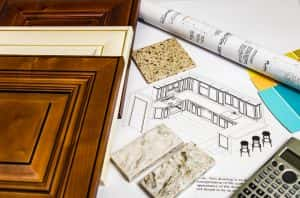 Modular kitchen features are inherently customisable, which is one of their greatest advantages. The flexibility afforded by these layouts makes them very versatile. These kitchens offer a wide range of standardised units that can be mixed and matched to create a layout tailored to the available space and your requirements. You can swap out cabinets, rearrange as you wish, and create a space that works perfectly well for your needs.
Modular kitchen features are inherently customisable, which is one of their greatest advantages. The flexibility afforded by these layouts makes them very versatile. These kitchens offer a wide range of standardised units that can be mixed and matched to create a layout tailored to the available space and your requirements. You can swap out cabinets, rearrange as you wish, and create a space that works perfectly well for your needs.
3. Use of Innovative Materials
From laminates to wood, glass, and metal, modular kitchens provide a diverse range of material options. This allows easy customisation of your kitchen’s aesthetic, to make sure it aligns with the décor theme that you’ve chosen for your home. The colours, finishes and styles of cabinetry can be customised to match your taste preferences, making your home all about you!
Characteristics of a Normal Kitchen Design
In contrast, let’s take a look at the characteristics of a ‘normal’ or carpenter-made kitchen!
Definition and Features
 A carpenter-made kitchen is crafted by hand by local carpenters. They follow traditional methods and tools to cut, size and plane the cabinets and assemble them by hand, entirely at the site. Every aspect, from cabinets to countertops, is individually designed and constructed to fit the specific dimensions and requirements of your space.
A carpenter-made kitchen is crafted by hand by local carpenters. They follow traditional methods and tools to cut, size and plane the cabinets and assemble them by hand, entirely at the site. Every aspect, from cabinets to countertops, is individually designed and constructed to fit the specific dimensions and requirements of your space.
1. Freestanding Furniture
In a carpenter-made kitchen, standalone pieces of furniture, such as freestanding cabinets, islands, and pantry units, are individually crafted by skilled carpenters. Each piece is meticulously designed to offer functional utility as well as aesthetic appeal, making for a more eclectic and personalised kitchen space.
Authentic, traditional furniture like this tells a deeply personal story, one that cannot be duplicated easily in any other home!
2. Limited Built-in Elements
While modular kitchens are designed to exacting sizes and perfect standards, a carpenter-built kitchen is one that’s crafted by hand, and may not have perfect sizes and finishes. These inherent flaws are, however, what makes a hand-crafted kitchen so unique.
Here, the built-in elements are limited, which makes for a kitchen that exudes character and authenticity. While this design choice allows for greater flexibility in the arrangement of furniture and a more open and adaptable kitchen layout, it also means that standard modular accessories and built-in elements will not fit perfectly into this kitchen.
3. Traditional Design Aesthetics
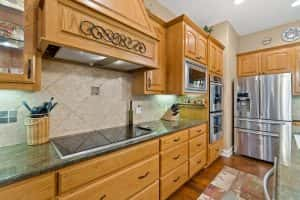
A carpenter-made kitchen comes with traditional aesthetics, which leans toward classic elements and timeless details that contribute to the overall charm of the interior. Natural materials like wood and stone are used, lending authenticity and enduring style.
Traditional kitchens often incorporate features like open shelving, plate racks, and furniture-style detailing, creating a welcoming and warm vintage-style atmosphere. The use of crown moulding, cornices, and decorative accents adds to the classic and elegant aesthetic.
Kitchen Design and Layout Comparison
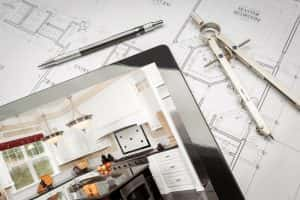 Let’s compare the layout and design aspects of carpenter kitchens and modular kitchens, to help you make the right choice!
Let’s compare the layout and design aspects of carpenter kitchens and modular kitchens, to help you make the right choice!
Modular Kitchen Layouts
The layout of a modular kitchen follows a more standardised approach, and designers tend to lean on predetermined layouts that suit common shapes and sizes of kitchens. Modular kitchen designs are definitely customisable, but the end result will never be as unique as a carpenter-made kitchen.
Normal Kitchen Layouts
On the other hand, the layout and design of a carpenter-made kitchen are completely unique and highly customisable. You can tailor sizes, finishes and materials to suit your unique quirks and preferences. Intricate detailing and personalised features are possible, unlike the case with a modular kitchen!
Cost and Installation Differences
What are the differences in cost and installation between a modular kitchen and a carpenter-made kitchen? Here’s the lowdown.
Modular Kitchen Costs

The cost of your modular kitchen will depend on various parameters, among them the size of your kitchen and the layout you choose. It goes without saying that the materials, finishes and accessories also play an important role.
1. Initial Investment
HomeLane’s rough and ready cost calculator indicates that the cost for a straight kitchen that’s 10 running feet in length for a small home ranges from INR 1.2 lakh to INR 1.3 lakh.
2. Long-Term Value
Modular kitchens offer great long-term value, provided you choose durable, high-quality materials and do not compromise on quality, perhaps by choosing a vendor who is offering a lower price but whose quality may be questionable.
3. Installation of Modular Kitchen
Modular kitchens are known for their quick and efficient installation. As the material is cut, sized and finished in the factory, the actual work at your site will not take longer than a week. There will be no delays and the process is extremely efficient.
Normal Kitchen Costs
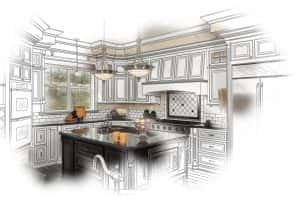
The costs of a normal or carpenter-made kitchen can vary a great deal, depending on the complexity of the design and the skill of the carpenter. The costs for a simple design for a small kitchen may be on par with the cost of a modular kitchen, or can be lower.
1. Budget Considerations
Setting a fixed budget for a regular kitchen can be tricky because costs may go up during the project, and material prices can change. With a modular kitchen, once you finalise the design there will be no escalation in prices. The vendor can manage any cost differences by buying materials in bulk and using standardised processes.
2. DIY vs. Professional Installation
A DIY kitchen can give you immense satisfaction, in terms of being able to see something take shape from the ground up! However, there will be mistakes made, which can be costly if a lot of rework is needed to fix the issues that arise. You can save on the costs of hiring a professional carpenter, making your overall expenses lower.
A professional carpenter will cost more for sure, but the work will be done neatly and in a capable manner. It will also get finished much faster, giving you a better return on your investment.
Pros and Cons of Each
While modular kitchens are all about efficiency and quick installation, carpenter-made kitchens focus on artisanal craftsmanship and the creation of a one-of-a-kind space that’s tailored to your vision and preferences.
In a nutshell, here are the pros and cons of each!
Modular Kitchen Advantages and Disadvantages
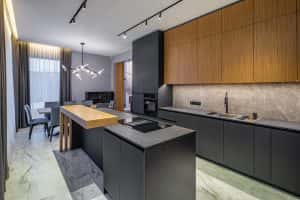 Advantages of modular kitchens:
Advantages of modular kitchens:
- They are designed for efficient space utilisation, offering clever storage solutions and organised layouts.
- There is no guesswork, as you will be shown a 3D view at the very outset. What you see is what you will get.
- Modular kitchens provide a consistent and coordinated look with standardised materials, colours, and finishes.
- You will get perfect finishes and accurate dimensions.
- These kitchens are often more budget-friendly due to standardised production processes and bulk material purchases.
- The costs are finalised at the outset and there will be no escalation in the estimate till the project is completed.
- Installation is quick and efficient with pre-fabricated components, minimising the time spent at your site.
- Your responsibility ends with the finalisation of designs and the payments, as the rest of the work will be dealt with by an expert project management team. You will not need to take time out to supervise or deal with any site issues yourself.
Disadvantages of modular kitchens:
- Your modular kitchen may lack the level of uniqueness and high customisation that’s possible with carpenter kitchens.
Normal Kitchen Advantages and Disadvantages
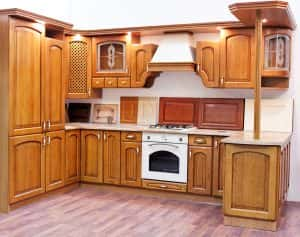 Advantages of normal kitchens:
Advantages of normal kitchens:
- A carpenter-made kitchen offers a high level of customisation, allowing for unique layouts and personalised design elements.
- You are given the flexibility to choose materials based on your tastes, and this makes for almost limitless options!
- The budget can be more adaptable, allowing for cost adjustments based on material and design choices.
Disadvantages of normal kitchens:
- It’s very easy for costs to get out of hand, especially with intricate customisation and high-quality materials.
- Timelines are rarely maintained, as the work depends on one set of carpenters who can fall ill or take leave due to exigencies.
- Installation usually takes longer as compared to modular kitchens, depending on the complexity of the design.
- The carpenters will be working at your site, often for months on end. This can lead to damages to your newly constructed premises.
- If the building is already occupied, your neighbour may have a lot of nasty things to say about the noise and debris!
- The work is done by hand, so perfect finishes cannot be expected.
- You will have to take time out to supervise and be actively involved in the work, as many issues can arise at site.
- Last but not least, the quality of the final product will, of course, depend on the skill level of the carpenters!
A Final Word
We hope we’ve given you enough inputs to decide the modular kitchen vs normal kitchen conundrum, once and for all!
Deciding between a modular kitchen and a regular kitchen depends on what’s important to you. If you want efficiency and cost savings, go for a modular kitchen. But if you prefer more customisation and a unique design, a regular kitchen might be the better choice! In the end, what it boils down to is your lifestyle, budget, and design preferences.
Considerations for Choosing the Right Kitchen Design
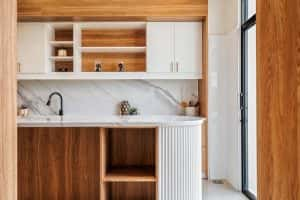
When deciding on the right kitchen design, you should keep a few factors in mind:
- Think about how you use your kitchen. Do you often cook elaborate meals, or is it more about quick and simple dishes? Your lifestyle plays a significant role in determining the functionality you need.
- Assess your budget realistically. Modular kitchens may offer cost savings, but if customisation is a priority, you might need to be prepared for potential cost increases.
- Evaluate the available space in your kitchen. If you have a compact area, modular designs could optimise space efficiently. However, if you have ample space, a normal kitchen might provide more creative layout options.
- Consider your design preferences. If you have a specific vision for your kitchen, a normal kitchen design allows for more personalised choices. Modular kitchens, while efficient, may limit your creativity a bit.
- Assess your timeline. If you need a quick installation, modular kitchens are known for their speed. On the other hand, if time is not a significant constraint, a carpenter kitchen might allow for more intricate designs.
Encouragement for Personalised Decision-Making
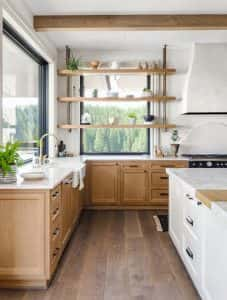
- Your kitchen is a reflection of your personal style. Don’t be afraid to make it uniquely yours, with elements that speak to your heart!
- Consider what you need most in your kitchen. If specific functionalities or storage solutions are crucial, tailor your design to meet those needs.
- Strike a balance between efficiency and uniqueness. There’s no doubt that a modular kitchen is efficient, but it’s your personal touches that make it warm and inviting.
- Always work closely with designers or carpenters during the decision-making process. Share your ideas, ask for suggestions, and co-create a design that combines your vision with their expertise!
In the end, choosing a kitchen is a deeply personal journey, and the decisions are all yours! For some handholding and a whole lot of help, connect with a HomeLane designer today. You can trust us to make your home interior journey as smooth and hassle-free as it could possibly ever be!


